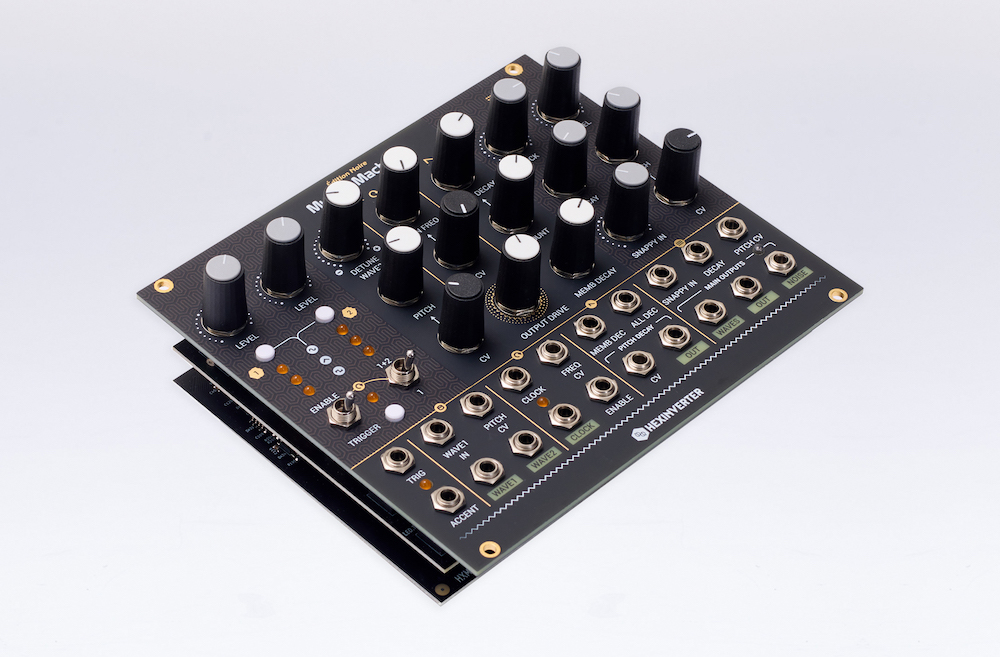April 2024 Eurorack round-up | Juno Daily
This month’s best new releases include an analogue percussion monster from Hexinverter and Erica Synths, plus three very different oscillators from Befaco, Noise Engineering and Klavis.

Hexinverter Mutant Machine
Reissued and reimagined by Erica Synths following the closure of Hexinverter, the Mutant Machine is a thing of beauty. What we have here is a strictly analogue percussion synthesis module loosely inspired by Roland TR-909 circuits but presented in a uniquely creative way. Dual ‘membrane’ and ‘snappy’ circuits are summed into a single output, giving you precise control over two independent elements of the sound. 909 snares and kicks are easily replicated, but the Mutant Machine’s real strength is the way it allows you to explore entirely new areas of sound design, from unique melodic hits through to drones.
There’s quite a lot to get your head around here, which makes the Mutant Machine a little less immediate than some percussion modules but does mean that it’s got hugely impressive depth and versatility once you explore all the different options.
Befaco Octaves VCO
Befaco’s interesting take on additive synthesis promises “harsh and funky” tones, but what’s most impressive in practice is how easy it is to get to grips with. Six different frequency bands represent square waves at multiples of the base frequency, each with its own volume slider and CV input to modulate the level. All six bands respond to pulse width modulation, while cascading outputs allow you to split the bands to separate destinations or take the sum of them as a whole.
It’s impossible not to get good results by blending the different overtones and experimenting with the harmonics. It’s a clever approach to additive synthesis, quite different to anything we’ve seen before and with a distinctive sound that should work well in a lot of different scenarios. Impressive stuff and great value at a little over £200.

Noise Engineering Cursus Iteritas Alia
Based on Noise Engineering’s Alia digital oscillator platform, the Cursus Iteritas is a dynamically generated wavetable VCO. It’s probably the most versatile of the Alia series so far, excelling at mellow, modulated textures but capable of grittier tones thanks to a wave folding option. There’s something very engaging about the Cursus approach, which feels almost like a hybrid of wavetable and subtractive approaches thanks to intuitive controls like Center, to select the central harmonic of the wavetable, and Structure, to adjust between odd and even harmonics.
It’s always worth a quick reminder of the underlying concept between Noise Engineering’s modules. Each one is based on a different hardware platform which is shared between various different modules. The hardware remains the same, but functionality can change quite dramatically depending on which firmware is installed. The benefit of this approach is that if you own one Alia module you can try out all the other Alia firmware on the same module. In the case of the Alia, options include the Basimilus Iteritas drum synth firmware, chiptune-esque Ataraxic Iteritas or phase modulation courtesy of the Debel Iteritas. All firmware versions are free to all Alia owners, and replacement face plates are available if you want to switch them over and change the front panel to match. Great value.

Klavis Twin Waves MK2
Designed to pack some versatile oscillator options into a compact format, Klavis’s updated Twin Waves module offers two channels which can be set independently to operate as audio-rate VCOs, LFOs or random modulation/trigger generators. The MK2 version adds new features and three dedicated modulation gain pots to help with some of the deeper sound options. That latter point is both the strength and potential sticking point with the Twin Waves: there’s a hell of a lot packed behind that simple front panel, but you do have to go digging a bit to explore all the options. If you’re willing to do the work, you’ll find a huge amount on offer here, with 20 algorithm-based synthesis types including everything from basic subtractive through to stacked oscillators, additive synthesis and ring modulation. Built-in scale quantisation and clockable LFO options add to the versatility. Worth the effort, and a lot of module for the money.
Greg Scarth

